-

人教版高中政治必修4在实践中追求和发展真理说课稿(二)
一、教学理论依据及设计理念以新课程理念和新课标为指针,依据建构主义理论、学科探究理论和多元智力理论,采用探究式的教学模式来组织实施本节课的教学。学生成为课堂的主体和知识的主动构建者。通过创设多种情境,让学生积极参与、体验、感悟,主动获得新知,并逐步提高学生发现问题、分析问题和解决问题的能力。教师从课堂的主宰变为课堂的主导,是学生学习活动的组织者、引导者和合作者。教学过程是一个发散式的学生自主学习的过程。采用自主、合作、探究式的教学方式,让学生有多元选择,激发他们的潜能,发展他们的个性。二、教材分析1.教材的地位与作用:本框题是《生活与哲学》第二单元《探索世界与追求真理》第六课“求索真理的历程”的第二节内容。本单元的核心问题是如何看待我们周围的世界,该问题也是《生活与哲学》整本书的核心问题之一。
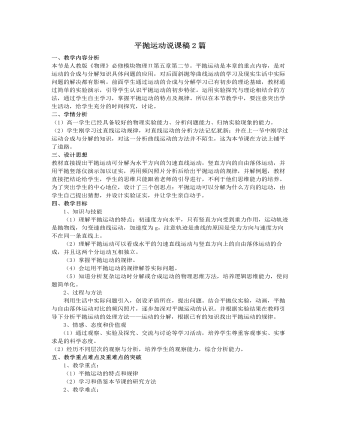
人教版新课标高中物理必修2平抛运动说课稿2篇
(5)高度不同,对平抛运动距离有何影响,是否因为高度减小后下落时间减小,所以要增大速度才能达到相同的距离?(教学实践证明,这种想法在学生比较多见。已经不自觉的沿用了自由落体运动的规律,又隐隐有运动等时性的痕迹。应引导学生这一结果还需实验验证。)教师的引导:其实,我们所提出的看法都跟平抛运动的规律有关系。那么平抛运动究竟有怎样的规律呢?以前学过的直线运动知识还能用于今天的内容吗?由此逐步使学生意识到分析平抛运动须采用运动合成与分解这一方法。三、实验验证自主探究(15分钟) 物理是实验科学,多媒体教学不能代替实验。本教学设计的第三个环节是实验验证,鼓励学生自主探究。引导学生根据自己的猜想(实验目的)设计实验进行验证。(1)介绍手持式平抛竖落仪,引导并小结实验要领:听两小球下落声音判断其下落时间。体会合运动和分运动是等时的。
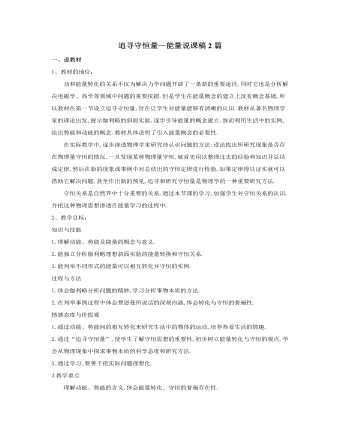
人教版新课标高中物理必修2追寻守恒量—能量说课稿2篇
[小结]师:下面同学们概括总结本节所学的内容。请一个同学到黑板上总结,其他同学在笔记本上总结,然后请同学评价黑板上的小结内容。 (学生认真总结概括本节内容,并把自己这节课的体会写下来、比较黑板上的小结和自己的小结,看谁的更好,好在什么地方。) 生:本节课我们通过伽利略理想斜面实验,分析得出了能量以及动能和势能的概念,从能量的相互转化角度认识到,在动能和势能的相互转化过程中,能的总量保持不变,即能量是守恒的。通过这节课的学习,使我们建立起了守恒的思想。 点评:总结课堂内容,培养学生概括总结能力。 教师要放开,让学生自己总结所学内容,允许内容的顺序不同,从而构建他们自己的知识框架。[布置作业]课后讨论 P3“问题与练习”中的问题。[课外训练]以竖直上抛的小球为例说明小球的势能和动能的转化情况。在这个例子中是否存在着能的总量保持不变?
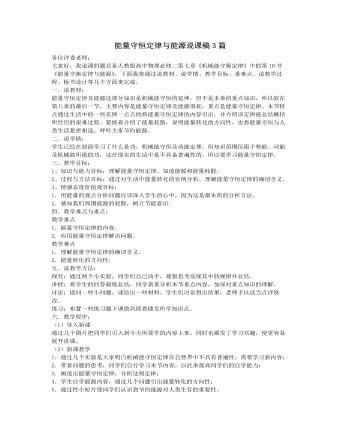
人教版新课标高中物理必修2能量守恒定律与能源说课稿3篇
(3)内陆和中西部城镇主要以煤和火电为主;广大农村和边远地区大多正从使用农作物秸秆等生物能源。(4)人均能源资源不足。我国是世界第三大能源生产国和第二大能源消费国,而我国能源短缺,特别是油气资源短缺已成为制约我国经济发展的重要因素。相关数据——煤炭、石油和天然气的人均资源占有量只有95t,世界平均值为209t,约是世界人均值的1/2;我国人均石油可采储量3t,世界平均值为28t,约为世界平均值的1/10。我国人均能源消费量不足1.2吨标准煤,居世界89位,不足世界人均能源消费水平的一半,仅占发达国家的1/5~1/10。其中人均消费650kg标准煤,是世界平均额的95%;人均消费石油相当145kg标准煤,为世界平均数的16.8%;人均消费天然气相当17.7kg标准煤,为世界平均数的3.9%;人均消费电力501.5kWh,为世界平均水平的25%。(5)是能源消费结构不合理,突出存在着一低两高:即电能消费比例低,非商品生物能源消费量高,一次性商品能源消费中原煤消费比重高。原煤消费达到75%,远高于26.2%的世界平均水平。
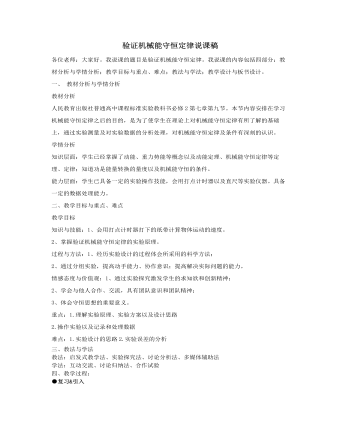
人教版新课标高中物理必修2验证机械能守恒定律说课稿
一、 教材分析与学情分析教材分析人民教育出版社普通高中课程标准实验教科书必修2第七章第九节。本节内容安排在学习机械能守恒定律之后的目的,是为了使学生在理论上对机械能守恒定律有所了解的基础上,通过实验测量及对实验数据的分析处理,对机械能守恒定律及条件有深刻的认识。学情分析知识层面:学生已经掌握了动能、重力势能等概念以及动能定理、机械能守恒定律等定理、定律;知道功是能量转换的量度以及机械能守恒的条件。能力层面:学生已具备一定的实验操作技能,会用打点计时器以及直尺等实验仪器。具备一定的数据处理能力。二、教学目标与重点、难点教学目标知识与技能:1、会用打点计时器打下的纸带计算物体运动的速度。2、掌握验证机械能守恒定律的实验原理。

人教版新课标高中物理必修2曲线运动说课稿2篇
1、举例:2、结论:(1)物体的运动轨迹是曲线的运动叫曲线运动。(2)曲线运动中速度方向是时刻改变的。(二)、曲线运动方向:1、质点在某一点(或某一时刻)的速度的方向是在曲线的这一点的切线方向。2、曲线运动中速度方向是时刻改变的,因此曲线运动是变速运动。(三)、曲线运动条件:1、演示实验:2、结论:当物体所受的合力的方向跟它的速度方向不在同一直线时,物体就做曲线运动。七、课堂小结:1、运动轨迹是曲线的运动叫曲线运动。2、曲线运动中速度的方向是时刻改变的,质点在某一点的瞬时速度的方向在曲线的这一点的切线上。3、当合外力F的方向与它的速度方向有一夹角a时,物体做曲线运动。八、巩固训练:1、关于曲线运动,下列说法正确的是()。A:曲线运动一定是变速运动;B:曲线运动速度的方向不断的变化,但速度的大小可以不变;
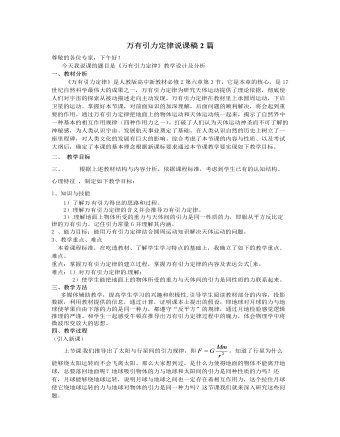
人教版新课标高中物理必修2万有引力定律说课稿2篇
学生中存在这样的问题:既然宇宙间的一切物体都是相互吸引的,那么为什么没有吸引到一起?为了解决这个问题,安排了例题2例2、两物体质量都是1kg,相距1m,它们间的万有引力是多少?通过本题,让学生认识到一般物体间的引力极小,不用考虑。那么,质量很大的天体为什么没被吸引到一块?从而引出下节课题。4.课堂小结:本节课,从天体运动出发,通过推理证明,形成理性认识,再结合例题习题使学生的理性认识再反馈到具体事实。形成实践-理论-实践的认知循环,顺应了认知规律.。本共设计了很多问,能让学生想的尽量让学生想、能学生说的尽量让学生说、能让学生做的尽量让学生做,全面发展学生的各方面能力。再通过作业和探究性课题使学生的思维活动在时空上得以延续。5.布置作业:布置作业时刻意安排引入:万有引力、重力、向心力、三者的联系,通过引导学生对比结果,从中发现问题:万有引力与重力向心力的关系与区别,为下节知识的难点突破作好了铺垫。
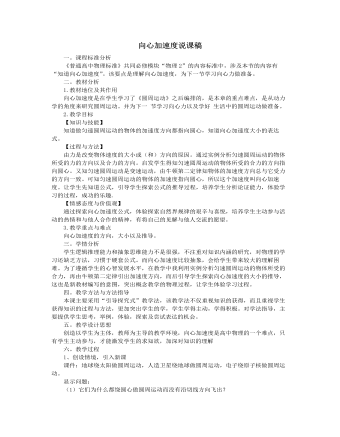
人教版新课标高中物理必修2向心加速度说课稿
d.某物体沿直线向东运动,原来的速度是5m/s,2s后速度减小到3m/s,求2s内物体速度变化。④如何探究物体作匀速圆周运动时,在Δt时间内的速度变化?分析:有了同一直线上速度变化的铺垫后,讨论物体做匀速圆周运动速度的变化就比较自然了,为了给向心加速度方向的学习打好基础,可以通过小组协作,进一步完成下列思考题,使同学们认识到:时间间隔起短,速度变化的方向起接近半径方向。(多媒体屏幕投影)a.物体沿半径为1m的轨道做匀速圆周运动,线速度大小为,求1s内物体速度变化并画出1s内速度变化的示意图。b.分别求出上题中物体在0.5s、0.25s内速度变化并画出相应的示意图。由于没有办法直接利用实验来验证速度变化的方向,所以,我们采用提供思考题的方法,引导同学在合作学习、自主探究中完成。有了速度变化的研究为铺垫,加速度的方向问题就迎刃而解了。
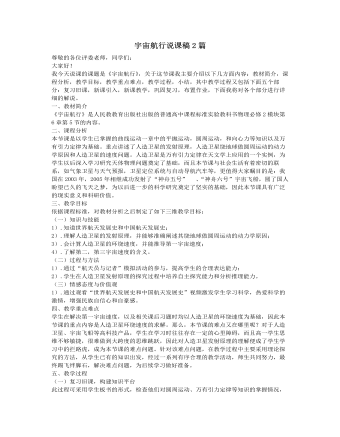
人教版新课标高中物理必修2宇宙航行说课稿2篇
了解了第一宇宙速度及其意义之后,继续提出问题,让学生思考:如果卫星的发射速度大于第一宇宙速度7.9km/s ,会出现什么情况呢?先让学生们大胆猜想,然后再向学生们介绍 卫星发射速度大于第一宇宙速度后的几种可能情况,引出第二宇宙速度和第三宇宙速度,让学生对第二、第三宇宙速度及其意义做定性了解。并通过演示Flash课件,帮助学生理解、加深学生印象。在学生对人造卫星的原理及发射卫星的速度条件有了初步了解后,接下来引导学生对卫星的运动规律作进一步的探索。实际上卫星并不是沿地表水平发射的,而是用火箭多次加速送到一定的高度的轨道后,再沿以地心为圆心的圆周的切线运行的。让学生继续深入思考:卫星在不同高度绕地球运行时的速度怎么求呢?将卫星送入低轨道和高轨道所需的速度都一样么?如果把不同轨道上的卫星绕地球的运动都看成是匀速圆周运动,引导学生利用已学的万有引力和圆周运动的相关知识,探究卫星绕地球的运行规律。
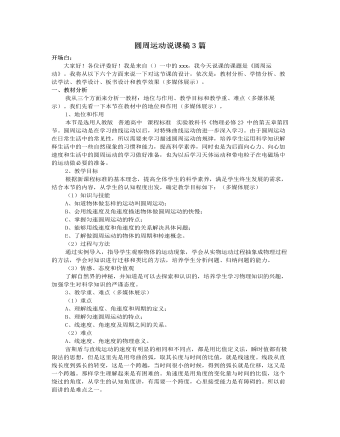
人教版新课标高中物理必修2圆周运动说课稿3篇
设计意图:通过设疑、讨论及学生的亲身体验与教师的引导,得到描述圆周运动快慢的两个物理量,也就成功的打破了学生在认识上的思维障碍,突破了物理概念教学的难点。在解决线速度和角速度的问题之后,我将引领学生学习匀速圆周运动的概念以及匀速圆周运动中线速度、角速度的特点。并引出匀速圆周运动中周期、转速的知识。为了加深学生对线速度、角速度与半径关系的认识,我设计了第三个学生体验活动:四名学生以我为圆心做圆周运动,四名学生始终并列,这时里圈同学走动不急不慢,而外圈同学则要小跑。通过学生的活动,不难发现在角速度相同的情况下,半径越大的线速度也越大。定性的得到了线速度、角速度与半径的关系。接下来让学生利用所学知识推导线速度、角速度与半径的关系。设计意图:这样就通过设疑、学生猜想、体验、推导的方式得到了结论,突破了本节课的难点即线速度、角速度与半径的关系。
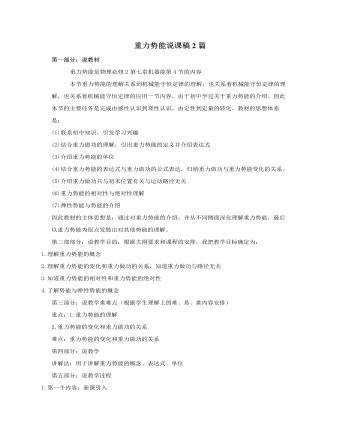
人教版新课标高中物理必修2重力势能说课稿2篇
(四)、弹性势能(据课时情况,可以让学生自学)生活中还有一些物体既没有运动也没有很大的高度却同样“储存”着能量,哪怕它只是孩童手里的玩具(图片:弹弓)。张紧的弓一撒手就会对箭支做功改变它的动能,松弛的弓有这样的本领吗?同样是弓前者具有能量而后者没有,那么什么情况下物体才具有这种能量呢?张紧的弓在恢复原状的过程会对外做功,但是拉断的弓还能有做功的本领吗?1.定义:物体由于发生弹性形变而具有的能量叫做弹性势能。2.弹性势能的大小与哪些因素有关呢?3、势能由相互作用的物体的相对位置决定的能量。重力势能:由地球和物体间相对位置决定。弹性势能:由发生形变的各部分的相对位置决定。(五).反馈练习1. 物体在运动过程中,克服重力做功50J, 则( )A.重力做功为50JB.物体的重力势能一定增加50JC.物体的重力势能一定减少50JD.重力做功为-50J
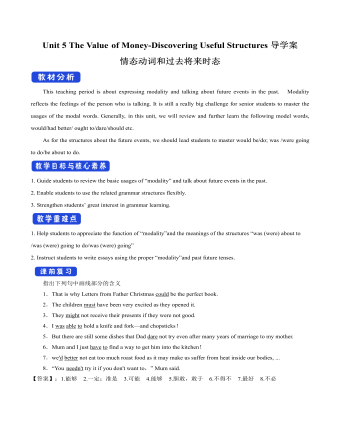
新人教版高中英语必修3Unit 5 The Value of Money-Discovering Useful Structures导学案
4.They were going to find someone to take part in their bet when they saw Henry walking on the street outside.[归纳]1.过去将来时的基本构成和用法过去将来时由“would+动词原形”构成,主要表示从过去某一时间来看将要发生的动作(尤其用于宾语从句中),还可以表示过去的动作习惯或倾向。Jeff knew he would be tired the next day.He promised that he would not open the letter until 2 o'clock.She said that she wouldn't do that again.2.表示过去将来时的其他表达法(1)was/were going to+动词原形:该结构有两个主要用法,一是表示过去的打算,二是表示在过去看来有迹象表明将要发生某事。I thought it was going to rain.(2)was/were to+动词原形:主要表示过去按计划或安排要做的事情。She said she was to get married next month.(3)was/were about to+动词原形:表示在过去看来即将要发生的动作,由于本身已含有“即将”的意味,所以不再与表示具体的将来时间状语连用。I was about to go to bed when the phone rang.(4)was/were+现在分词:表示在过去看来即将发生的动作,通常可用于该结构中的动词是come,go,leave,arrive,begin,start,stop,close,open,die,join,borrow,buy等瞬间动词。Jack said he was leaving tomorrow.
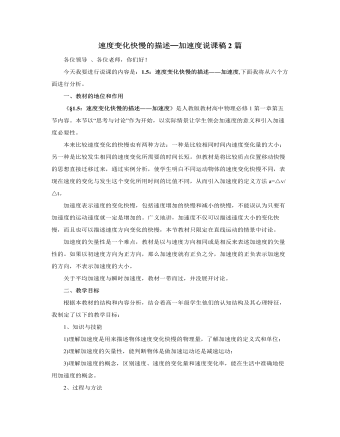
人教版新课标高中物理必修1速度变化快慢的描述─加速度说课稿2篇
本来比较速度变化的快慢也有两种方法:一种是比较相同时间内速度变化量的大小;另一种是比较发生相同的速度变化所需要的时间长短。但教材是将比较质点位置移动快慢的思想直接迁移过来,通过实例分析,使学生明白不同运动物体的速度变化快慢不同,表现在速度的变化与发生这个变化所用时间的比值不同,从而引入加速度的定义方法a=△v/△t。加速度表示速度的变化快慢,包括速度增加的快慢和减小的快慢,不能误认为只要有加速度的运动速度就一定是增加的。广义地讲,加速度不仅可以描述速度大小的变化快慢,而且也可以描述速度方向变化的快慢,本节教材只限定在直线运动的情景中讨论。加速度的矢量性是一个难点,教材是以与速度方向相同或是相反来表述加速度的矢量性的。如果以初速度方向为正方向,那么加速度就有正负之分,加速度的正负表示加速度的方向,不表示加速度的大小。
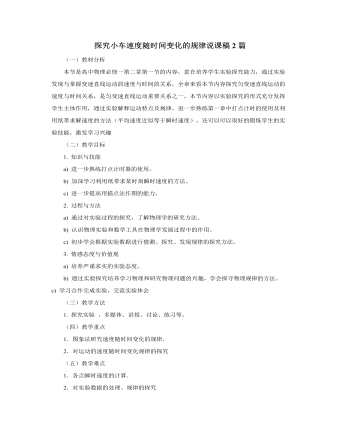
人教版新课标高中物理必修1探究小车速度随时间变化的规律说课稿2篇
(三)合作交流能力提升教师:刚才我们通过实验了解了小车的速度是怎样随时间变化的,但实验中有一定的误差,请同学们讨论并说出可能存在哪些误差,造成误差的原因是什么?(每个实验小组的同学之间进行热烈的讨论)学生:测量出现误差。因为点间距离太小,测量长度时容易产生误差。教师:如何减小这个误差呢?学生:如果测量较长的距离,误差应该小一些。教师:应该采取什么办法?学生:应该取几个点之间的距离作为一个测量长度。教师:好,这就是常用的取“计数点”的方法。我们应该在纸带上每隔几个计时点取作一个计数点,进行编号。分别标为:0、1、2、3……,测各计数点到“0”的距离。以减小测量误差。教师:还有补充吗?学生1:我在坐标系中描点画的图象只集中在坐标原定附近,两条图象没有明显的分开。学生2:描出的几个点不严格的分布在一条直线上,还能画直线吗?

人教A版高中数学必修一诱导公式教学设计(1)
一、复习回顾,温故知新1. 任意角三角函数的定义【答案】设角 它的终边与单位圆交于点 。那么(1) (2) 2.诱导公式一 ,其中, 。终边相同的角的同一三角函数值相等二、探索新知思考1:(1).终边相同的角的同一三角函数值有什么关系?【答案】相等(2).角 -α与α的终边 有何位置关系?【答案】终边关于x轴对称(3).角 与α的终边 有何位置关系?【答案】终边关于y轴对称(4).角 与α的终边 有何位置关系?【答案】终边关于原点对称思考2: 已知任意角α的终边与单位圆相交于点P(x, y),请同学们思考回答点P关于原点、x轴、y轴对称的三个点的坐标是什么?【答案】点P(x, y)关于原点对称点P1(-x, -y)点P(x, y)关于x轴对称点P2(x, -y) 点P(x, y)关于y轴对称点P3(-x, y)
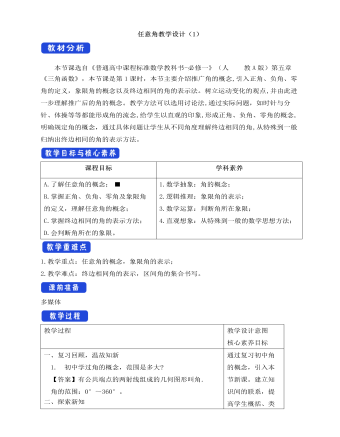
人教A版高中数学必修一任意角教学设计(1)
本节课选自《普通高中课程标准数学教科书-必修一》(人 教A版)第五章《三角函数》,本节课是第1课时,本节主要介绍推广角的概念,引入正角、负角、零角的定义,象限角的概念以及终边相同的角的表示法。树立运动变化的观点,并由此进一步理解推广后的角的概念。教学方法可以选用讨论法,通过实际问题,如时针与分针、体操等等都能形成角的流念,给学生以直观的印象,形成正角、负角、零角的概念,明确规定角的概念,通过具体问题让学生从不同角度理解终边相同的角,从特殊到一般归纳出终边相同的角的表示方法。A.了解任意角的概念;B.掌握正角、负角、零角及象限角的定义,理解任意角的概念;C.掌握终边相同的角的表示方法;D.会判断角所在的象限。 1.数学抽象:角的概念;2.逻辑推理:象限角的表示;3.数学运算:判断角所在象限;4.直观想象:从特殊到一般的数学思想方法;
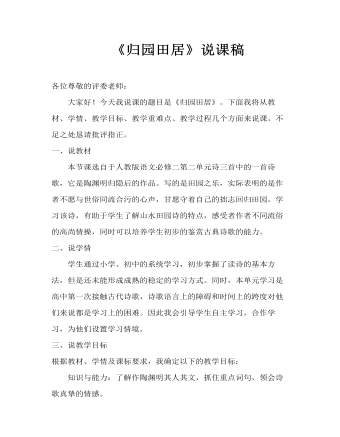
高中语文人教版必修二《归园田居》说课稿
一、说教材本节课选自于人教版语文必修二第二单元诗三首中的一首诗歌,它是陶渊明归隐后的作品。写的是田园之乐,实际表明的是作者不愿与世俗同流合污的心声,甘愿守着自己的拙志回归田园。学习该诗,有助于学生了解山水田园诗的特点,感受者作者不同流俗的高尚情操,同时可以培养学生初步的鉴赏古典诗歌的能力。
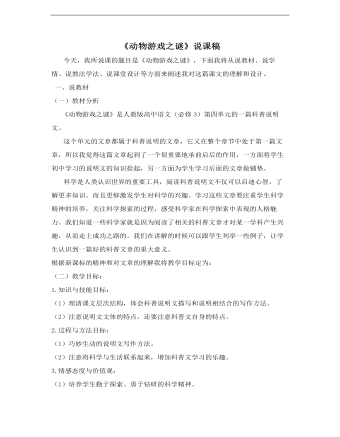
高中语文人教版必修三《动物游戏之谜》说课稿
科学是人类认识世界的重要工具,阅读科普说明文不仅可以启迪心智,了解更多知识。而且更够激发学生对科学的兴趣。学习这些文章要注重学生科学精神的培养,关注科学探索的过程,感受科学家在科学探索中表现的人格魅力。我们知道一些科学家就是因为阅读了相关的科普文章才对某一学科产生兴趣,从而走上成功之路的。我们在讲解的时候可以跟学生列举一些例子,让学生认识到一篇好的科普文章的重大意义。
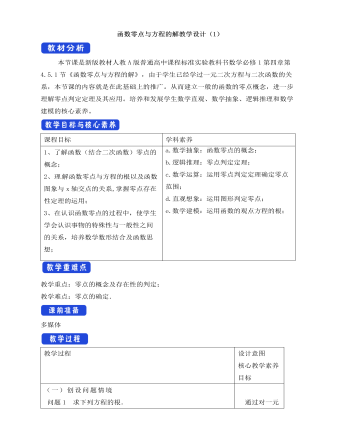
人教A版高中数学必修一函数的零点与方程的解教学设计(1)
本节课是新版教材人教A版普通高中课程标准实验教科书数学必修1第四章第4.5.1节《函数零点与方程的解》,由于学生已经学过一元二次方程与二次函数的关系,本节课的内容就是在此基础上的推广。从而建立一般的函数的零点概念,进一步理解零点判定定理及其应用。培养和发展学生数学直观、数学抽象、逻辑推理和数学建模的核心素养。1、了解函数(结合二次函数)零点的概念;2、理 解函数零点与方程的根以及函数图象与x轴交点的关系,掌握零点存在性定理的运用;3、在认识函数零点的过程中,使学生学会认识事物的特殊性与一般性之间的关系,培养数学数形结合及函数思想; a.数学抽象:函数零点的概念;b.逻辑推理:零点判定定理;c.数学运算:运用零点判定定理确定零点范围;d.直观想象:运用图形判定零点;e.数学建模:运用函数的观点方程的根;
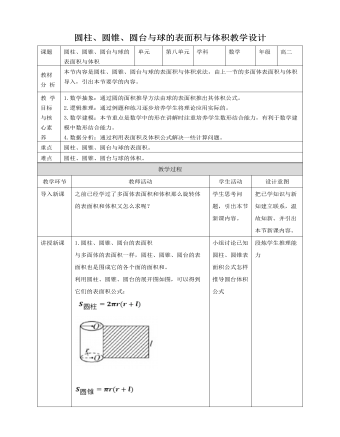
人教A版高中数学必修二圆柱、圆锥、圆台和球的表面积与体积教学设计
1.圆柱、圆锥、圆台的表面积与多面体的表面积一样,圆柱、圆锥、圆台的表面积也是围成它的各个面的面积和。利用圆柱、圆锥、圆台的展开图如图,可以得到它们的表面积公式:2.思考1:圆柱、圆锥、圆台的表面积之间有什么关系?你能用圆柱、圆锥、圆台的结构特征来解释这种关系吗?3.练习一圆柱的一个底面积是S,侧面展开图是一个正方体,那么这个圆柱的侧面积是( )A 4πS B 2πS C πS D 4.练习二:如图所示,在边长为4的正三角形ABC中,E,F分别是AB,AC的中点,D为BC的中点,H,G分别是BD,CD的中点,若将正三角形ABC绕AD旋转180°,求阴影部分形成的几何体的表面积.5. 圆柱、圆锥、圆台的体积对于柱体、锥体、台体的体积公式的认识(1)等底、等高的两个柱体的体积相同.(2)等底、等高的圆锥和圆柱的体积之间的关系可以通过实验得出,等底、等高的圆柱的体积是圆锥的体积的3倍.





















